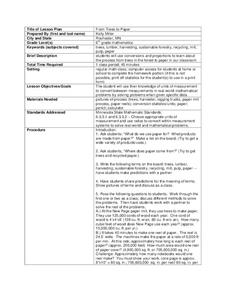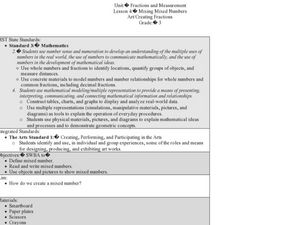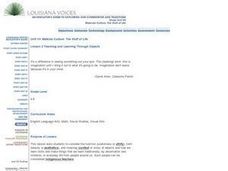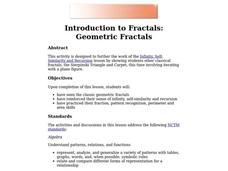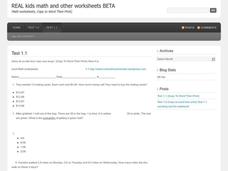Curated OER
From Trees to Paper
Sixth graders investigate logging and the process of paper making. In this forestry lesson, 6th graders analyze pictures of trees being processed into the paper they use everyday. Students solve and create math problems based...
Curated OER
Falling Into Geometry Through Paper Art
Students explore geometric shapes. In this kindergarten geometry lesson, students create a fall quilt consisting of three different paper geometric quilt squares that when assembled form a scarecrow, a pumpkin, and a crow. ...
Curated OER
Mixing Mixed Numbers Art/Creating Fractions
Third graders explore number values by participating in class math activities. In this fractions lesson, 3rd graders collaborate with classmates to discuss the technique of adding mix numbers while utilizing paper plates to help...
Curated OER
Water Treatment Plant Tour
Students define vocabulary related to geometry and calculate the volume. In this geometry lesson, students calculate flow rates, and volume as it relates to a water plant facility. They calculate the volume of three dimensional shapes...
Curated OER
Relationship Between Addition and Subtraction
Students are taught how to add and subtract and use number sense to solve basic math problems. In this addition and subtraction instructional activity, students are being taught using theories from different philosophers in education....
Curated OER
Fun Wth Angles
Fourth graders explore angles in everyday life. In this angles lesson plan, 4th graders view examples of angles, then search magazines, newspapers and catalogues for more examples. Students work in pairs and check each other's work.
Curated OER
Symmetry
Third graders find symmetry in nature. In this symmetry lesson, 3rd graders discover that symmetry is in nature and our everyday world. Students examine the alphabet for symmetrical letters then create their own artwork showing symmetry.
Curated OER
Teaching and Learning Through Objects
Students identify and interpret the function, usefulness or utitlity, form, beauty or aesthetics, and meaning, context or story, of objects and how they learn new skills and make things that they learn traditionally, by observation and...
Curated OER
Mathematical Metaphors in Art
Learners investigate the role of mathematics in their everyday lives. They discover, through reading a Times article and through analyzing a specific example of art, that mathematics exists on a deeper 'metaphoric' level in art.
Curated OER
Horticulture and Gardening
This 6 page information packet provides an overview of gardening and plants. Using this activity, students could design their own gardens, using math, science and writing skills. There are 30 questions involved.
Curated OER
Triangles
Fourth graders participate in three experiments to gain understanding of triangles. In this triangles lesson, 4th graders use pipe cleaners to create bubble pipes, basketball hoops and bingo cards to display the characteristics of...
Curated OER
Government Goods and Services
Fifth graders investigate the connection between taxes and government services. In this economics lesson plan, 5th graders discuss the process and benefits of paying sales and income taxes. Using calculators, students compute...
Curated OER
Hoe Long Does it Take to Get to a Star
Students calculate the distance in light years. In this geometry activity, students solve problems involving distance, using the distance formula. They rewrite big numbers using scientific notations and apply their knowledge of everyday...
Curated OER
Let's Go Shopping: Estimation At The Mall
Students estimate the total cost of a shopping trip. In this estimation lesson, students use three different techniques to estimate how much a shopping trip will cost.
Curated OER
Engineer Webelos Activity Workbook
In this engineering worksheet, students speak with an engineer, surveyor, or architect in their area about the various occupations in engineering and create a list that explains each. They also draw a floor plan of their home and three...
Curated OER
Introduction to Fractals: Geometric Fractals
Students study and observe the patterns made by the areas of the Sierpinski Triangle. Students use the computer to draw two or three iterations to discover the number patterns. Students complete worksheets based on Geometric Fractals.
Curated OER
Magician Squares
Elementary school learners investigate the attributes of a square. They discover that squares are polygons and examine squares found in everyday life. They concentrate on connecting the word, square, with the shape. As an...
Curated OER
Reviewing Facts Through 10
Manipulatives are always fun for children to use. They use connecting cubes and blocks to solve addition and subtraction word problems with numbers up to 10. They then play a math game and use their cube to create number sentences....
Curated OER
Probability: 3
In this probability instructional activity, students complete probability word problems involving one digit numbers. Students complete 6 problems total.
Curated OER
Earth Moon Scaling
A wonderful lesson incorporating math and physics skills along with specific details about the planetary bodies. The cross-curricular approach makes for a valid activity to challenge multiple ages and abilities. Your class could work in...
Curated OER
Math Word Problems
For this problem solving worksheet, students solve six multiple choice word problems that involve finding probability and identifying monetary amounts.
Curated OER
Congruent Containers
In this congruency worksheet, students find congruency in everyday packaging on everyday items and answer questions about them. Students answer 4 questions.
Inside Mathematics
Marble Game
Pupils determine the theoretical probability of winning a game of marbles. Individuals compare the theoretical probability to experimental probability for the same game. They continue on to compare two different probability games.
Curated OER
My Test Book: Multiplication and Division
In this online interactive math skills worksheet, students solve 10 multiple choice math problems that require them to multiply and divide with 2-digit numbers. Students may submit their answers to be scored.
